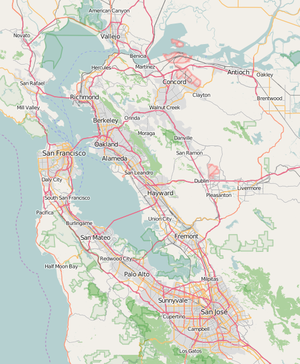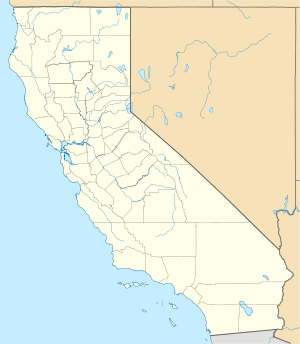This article includes a list of general references, but it lacks sufficient corresponding inline citations. (September 2013) |
The Marin Islands are two small islands, named East Marin and West Marin, in San Rafael Bay, an embayment of San Pablo Bay in Marin County, California.
| Marin Islands National Wildlife Refuge | |
|---|---|
IUCN category IV (habitat/species management area) | |
 View of both Marin Islands, from the East Peak of Mount Tamalpais. | |
| Location | San Pablo Bay, Marin County, California, U.S. |
| Nearest city | San Rafael, California |
| Coordinates | 37°57′55″N 122°28′16″W / 37.96514°N 122.47116°W[1] |
| Established | 1992 |
| Governing body | U.S. Fish and Wildlife Service |
| Website | Marin Islands National Wildlife Refuge |

Geography
editThe Marin Islands are located offshore from the city of San Rafael, in the northern San Francisco Bay Area. The islands comprise the Marin Islands National Wildlife Refuge, which was established in 1992. The surrounding submerged tidelands are also included in the refuge. The islands are the property of the U.S. Fish and Wildlife Service and require special permission to visit.
History
editThe islands are named after the Coast Miwok man known as Chief Marin, after whom Marin County was later named. He is thought to have hidden out there in the 1820s after escaping from Mission San Rafael, before being recaptured and incarcerated at the Mexican San Francisco Presidio.[2]
The islands were donated to the federal government by the Crowley family of San Francisco. They had been bought by Thomas Crowley at auction in 1926 for $25,000 in the hope that they would become the western terminus of the Richmond–San Rafael Bridge. Instead, they became a family vacation spot for more than sixty years.
Ecology
editWest Marin Island, elevation 26 meters (85 ft) above the bay waters, supports the largest heron and egret rookery in the San Francisco Bay Area. Nesting species include great egrets, snowy egrets, great blue herons, and black-crowned night herons.
East Marin Island, a former vacation retreat, now supports a variety of introduced and native plants and provides critical nesting material and rest sites for the nearby colony.
The submerged tidelands support a variety of resident and migratory water birds such as surf scoter, black oystercatcher, diving ducks, and osprey. Refuge objectives are to protect migratory species, including the heron and egret nesting colony, protect and restore suitable habitat for the colony, and protect the tidal mud flats and unique island ecosystem.
See also
editReferences
edit- Martin, James A.; Lee, Michael T. (2006). The Islands of San Francisco Bay. San Rafael, CA: Down Window Press. ISBN 0-9787241-0-0.
- Fish and Wildlife Service (3 March 2009). "Marin Islands NWR". U.S. Department of the Interior. Retrieved 2009-09-05.
- Refuge profile
- Refuge website
- ^ "Marin Islands National Wildlife Refuge". Geographic Names Information System. United States Geological Survey, United States Department of the Interior.
- ^ Goerke, Betty. 2007. Chief Marin, Leader, Rebel, and Legend: A History of Marin County's Namesake and his People. Berkeley: Heyday Books. ISBN 978-1-59714-053-9
This article incorporates public domain material from websites or documents of the United States Fish and Wildlife Service.


